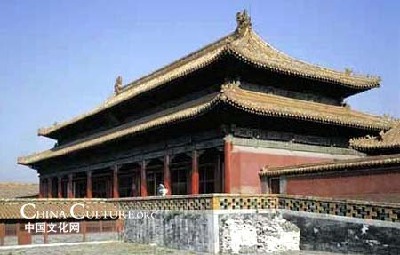|
|
|
| |
The Palace Museum
The Hall of Central Harmony is a smaller, square hall, used by the Emperor to prepare and rest before and during ceremonies. Behind it, the Hall of Preserving Harmony, was used for rehearsing ceremonies, and was also the site of the final stage of the Imperial examination. All three halls feature imperial thrones, the largest and most elaborate one being that in the Hall of Supreme Harmony.
At the centre of the Inner Court is another set of three halls. From the south, these are the Palace of Heavenly Purity, Hall of Union, and the Palace of Earthly Tranquility. Smaller than the Outer Court halls, the three halls of the Inner Court were the official residences of the Emperor and the Empress. The Emperor, representing Yang and the Heavens, would occupy the Palace of Heavenly Purity. The Empress, representing Yin and the Earth, would occupy the Palace of Earthly Tranquility. In between them was the Hall of Union, where the Yin and Yang mixed to produce harmony.

Palace of Heavenly Purity

Palace of Earthly Tranquility
The buildings of the two courts were laid out precisely in accordance with a code of architectural hierarchy, which designated specific features to reflect the paramount authority and status of the emperor. No ordinary mortal would have been allowed or even dared to come within close proximity of these buildings.
The Imperial Garden is in the north of the Inner Court. Though it is called a garden, all the structures, roads, ponds and even flower beds and plants are regular and symmetrical, with only some local changes, differing, vastly from the free pattern which is especially emphasized in Chinese gardens.
Getting through a small square to the north of the Imperial Garden, one finds Shenwu Men where there is a high tower. Passing the gate through the city moat leads one to Jingshan, the end of Forbidden City. Jingshan is high in the middle and low on both sides, in line with the encircling hill, on the ridge of which are five pavilions.
The Forbidden City is the best model in the design of a complex of buildings in ancient Chinese architectural art. It enjoys a high reputation throughout the world. Referring to it in his famous work, The Science and Civilization of China, Joseph Needham, a well-known British scholar, said: We discover a series of separate spaces which are linked to each other...they are contrary to palaces during the Renaissance age, for example, for example, in Versailles, where the visual point is completely concentrated in a single structure, and the palace is separate from the city. In contrast, China's concept is very profound and complicated, because in a composition of the picture there are hundreds of structures, and a palace itself is only a part of a greater organic body of the entire city together with its city walls and streets.
The Chinese concept is also extremely delicate and changeable involving blended interests. He said the whole form of China's great architecture has become an organic pattern that no culture can surpass.
Travel tips:
1. At Meridian Gate, visitors can rent a walkman guide in different languages that introduces the history and architecture of the palace. The tape and player should be returned at the north gate of the Palace Museum upon exiting.
2. Don't forget to visit the Jingshan (Coal Hill) Park, opposite to the palace's north gate. From this location can see the splendid layout of the palace.
How to get there: Subways: Line 1: get down at Tian'anmen East, Loop Line: get down at Qianmen; Bus No. 1, 4, 5, 10, 20, 22, 52, 57, 802; It is within walking distance from Wangfujing, Xidan or Qianmen. Tel: 86-10-65132255
Address: 4 Jingshan Qianjie, Beijing ,100009 China
General Enquiries
Tel: (8610) 8500-7421, (8610) 8500-7420
Email: gugong@dpm.org.cn
Fax: (8610) 8500-7079
Other Enquiries:
Tour guide service: (8610) 8500-7427 (at the Meridian Gate [Wu men]), (8610) 8500-7428 (at the Gate of Divine Prowess [Shenwu men])
Website: http://www.dpm.org.cn/shtml/2/@/8797.html
|
|
| |
 |
|
|
|
|
